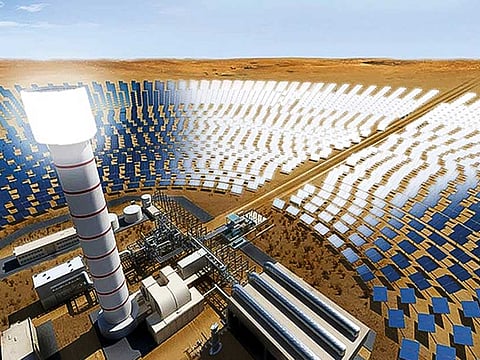UAE aims to be best-prepared country to tackle climate change
National Climate Change Plan 2050 designed to ensure country is best positioned to adapt to climate change

Abu Dhabi: Almost half of the country’s power needs will be generated from renewable sources by 2050, said a senior official.
“By 2050, 44 per cent of the country’s energy usage would come from renewable sources — 38 per cent from gas, 12 per cent from cleaner fossil fuel, and six per cent from nuclear power,” Fahd Mohammad Al Hammadi, director of the Climate Change Department at the Ministry of Climate Change and Environment, told a news conference in Abu Dhabi on Tuesday.
He said the UAE aims to become the world’s best-prepared country to tackle the challenges that climate change will bring.
“UAE National Climate Change Plan 2050 is designed to ensure the country is best positioned to adapt to the challenges that climate change and global warning pose,” Al Hammadi said.
He said the plan will seek to steer the country towards a climate resilient, sustainable economy that will protect the environment and ensure a high quality of life for future generations.
Al Hammadi added the plan, one of a kind in the region, is the culmination of years of several environmental strategies, including the UAE’s commitment to the Paris Agreement in 2015 to restrict global temperature increases to well below 2 degree Celsius in the century ahead.
“The plan will serve as a road map to bolster nationwide action for climate mitigation and adaptation in the UAE to 2050. The objectives are three-fold — managing greenhouse emissions while sustaining economic growth, building climate resilience through stronger climate adaptation and advancing the UAE’s economic diversification agenda through innovative solutions,” Al Hammadi said.
He asserted the UAE has been a pioneer in protecting the environment. From harnessing green energy and solar power, protecting the marine environment to recycling waste and promoting public transport, it has looked at every aspect of living and has tried to protect our planet.
“The plan reflects the UAE’s approach to sustainable development. It comes as part of the government’s efforts to achieve the UAE Vision 2021. It also builds on policies such as the National Green Development Strategy, designed to transform the country’s economy into a diversified green economy by 2030,” Al Hammadi added.
Al Hammadi said the plan integrates existing environmental policies and measures in line with the country’s future sustainable development plans. It will provide data and proposals for strengthening national efforts to address climate change issues and reduce their impact on ecosystems and economy. On a broader canvas, the plan will complement the country’s efforts in the field of climate change, within a broad framework and time frame.
The plan has identified three key priorities: First, making a difference in inventory and management of greenhouse gas emissions by combining dispersed efforts at the sectoral and local levels, developing a unified and comprehensive framework for the measurement of emissions and reporting. It also seeks to establish an integrated monitoring, reporting and verification system by applying international best practices. In addition, a national climate information system will be developed to take advantage of emission data in support of scientific research and prediction of the impact of climate change on the country.
Second, mainstreaming climate flexibility into levels and sectors of development plans of the country.
Third, contributing effectively to the country’s orientation towards economic diversification by providing effective systems and incentives that support private sector participation in the development process and ensure the promotion of the market for environmental products and services in the country.
Objectives of National Climate Change Plan 2050
Manage greenhouse gas emissions while sustaining economic growth
Build climate resilience by minimising risks and increasing capacity for climate adaptation
Advance the UAE’s economic diversification agenda through innovative solutions
Climate change in the UAE
The most vulnerable areas to climate change in the UAE are water, coastal and marine, dryland ecosystems, buildings and infrastructure, agriculture and food security, and public health. Based on the analysis of past and present anthropogenic drivers, future projections using climate models suggest an increase in the UAE’s annual average temperature of around 1 degree Celsius by 2020 and between 1.5C-2C by 2040.
The effects of climate change are likely to be felt most severely in coastal zones, where marine habitats will suffer from rising water temperatures and salinity, whereas infrastructure will be tested by storm surges and sea level rise. Other risks include weakened food security and health damage from extreme heat events.
Results of local climate change studies and research show that climate change could have implications on the UAE’s development objectives. Direct impacts of extreme weather events as well as slow-onset phenomena such as sea level rise could disrupt the daily functioning of transport and infrastructure, impact the value of real estate, affect environmental assets, and damage the tourism industry. If climate change is left unmanaged, consequences will be felt across the nation and could slow down the UAE’s efforts toward economic diversification.
Sign up for the Daily Briefing
Get the latest news and updates straight to your inbox


